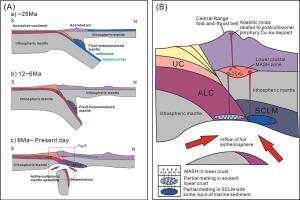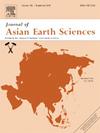Geochemical constraints on the petrogenesis of Cenozoic adakitic porphyries in West Papua, Indonesia: implications for the metallogeny of the Grasberg Cu-Au deposit and associated tectonic evolution
IF 2.4
3区 地球科学
Q2 GEOSCIENCES, MULTIDISCIPLINARY
引用次数: 0
Abstract
The Cenozoic porphyries in the Grasberg area host a supergiant Cu–Au porphyry deposit in West Papua, Indonesia. These rocks display adakite-like geochemical features, including high Sr/Y and (La/Yb)N ratios, high Al2O3 and K2O, low Y and Yb, and radiogenic Pb isotopes, distinguishing them from typical lower crustal melts. Integrated zircon U–Pb–Hf, whole-rock Sr–Nd–Pb isotopes, and trace element data indicate that three monzonite porphyries crystallized at 3.06 ± 0.19 Ma, 2.93 ± 0.16 Ma, and 2.86 ± 0.17 Ma. They show negative whole-rock εNd(t) (–9.8 to –8.5) and zircon εHf(t) (–20 to –1), high Ce4+/Ce3+ ratios (11.4–9056.7), and elevated oxygen fugacity, consistent with formation from oxidized, metal-fertile magmas.We propose that Grasberg porphyries formed by partial melting of an enriched, metasomatized lithospheric mantle mixed with melts from ancient lower continental crust. Mantle-derived magmas supplied heat, initial Cu–Au, high water content, and elevated fO2, while crustal melts imparted adakitic signatures. Regional tectonics involved collisional delamination of the Australian continental lithosphere (starting ∼6 Ma), upwelling of hot asthenosphere, and decompression of stretched lithospheric mantle, promoting partial melting and magma mixing. Subsequent strike-slip faulting created pathways for shallow emplacement of adakitic monzonites, generating Cu–Au mineralization.High Ce4+/Ce3+ ratios and δ34S values of pyrite and chalcopyrite indicate a magmatic source and strongly oxidized conditions, explaining the exceptional metal enrichment. This study establishes a geodynamic framework for the formation of igneous intrusions and the supergiant Grasberg Cu–Au deposit in a post-collisional, thin back-arc setting.

印尼西巴布亚新生代埃达克质斑岩岩石成因的地球化学约束:对Grasberg铜金矿床成矿作用及相关构造演化的启示
印度尼西亚西巴布亚格拉斯伯格地区新生代斑岩中赋存一超大型铜金斑岩矿床。这些岩石具有高Sr/Y和(La/Yb)N比、高Al2O3和K2O、低Y和Yb、低放射性成因Pb同位素等类似埃达岩的地球化学特征,与典型的下地壳熔体不同。综合锆石U-Pb-Hf、全岩Sr-Nd-Pb同位素和微量元素数据表明,三种二长岩斑岩的结晶温度分别为3.06±0.19 Ma、2.93±0.16 Ma和2.86±0.17 Ma。全岩εNd(t)为负(-9.8 ~ -8.5),锆石εHf(t)为负(-20 ~ -1),Ce4+/Ce3+比值高(11.4 ~ 9056.7),氧逸度高,与富金属氧化岩浆形成一致。我们认为格拉斯伯格斑岩是由富交代岩石圈地幔与古代下大陆地壳熔体的部分熔融混合形成的。地幔岩浆提供了热量、初始铜金、高含水量和高fO2,而地壳熔体则提供了埃达质特征。区域构造包括澳大利亚大陆岩石圈的碰撞剥离(开始于~ 6 Ma)、热软流圈的上涌和拉伸岩石圈地幔的减压,促进了部分熔融和岩浆混合。随后的走滑断裂为埃达克质二长岩的浅层侵位创造了通道,形成了铜金成矿作用。黄铁矿和黄铜矿的高Ce4+/Ce3+比值和δ34S值表明其岩浆源和强氧化条件,解释了异常的金属富集。本研究建立了碰撞后薄弧后背景下火成岩侵入体和超巨型格拉斯伯格铜金矿床形成的地球动力学框架。
本文章由计算机程序翻译,如有差异,请以英文原文为准。
求助全文
约1分钟内获得全文
求助全文
来源期刊

Journal of Asian Earth Sciences
地学-地球科学综合
CiteScore
5.90
自引率
10.00%
发文量
324
审稿时长
71 days
期刊介绍:
Journal of Asian Earth Sciences has an open access mirror journal Journal of Asian Earth Sciences: X, sharing the same aims and scope, editorial team, submission system and rigorous peer review.
The Journal of Asian Earth Sciences is an international interdisciplinary journal devoted to all aspects of research related to the solid Earth Sciences of Asia. The Journal publishes high quality, peer-reviewed scientific papers on the regional geology, tectonics, geochemistry and geophysics of Asia. It will be devoted primarily to research papers but short communications relating to new developments of broad interest, reviews and book reviews will also be included. Papers must have international appeal and should present work of more than local significance.
The scope includes deep processes of the Asian continent and its adjacent oceans; seismology and earthquakes; orogeny, magmatism, metamorphism and volcanism; growth, deformation and destruction of the Asian crust; crust-mantle interaction; evolution of life (early life, biostratigraphy, biogeography and mass-extinction); fluids, fluxes and reservoirs of mineral and energy resources; surface processes (weathering, erosion, transport and deposition of sediments) and resulting geomorphology; and the response of the Earth to global climate change as viewed within the Asian continent and surrounding oceans.
 求助内容:
求助内容: 应助结果提醒方式:
应助结果提醒方式:


